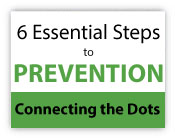
As mentioned in Part 4 of this blog series, there are 6 Essential Steps to Proactive Prevention, Awareness is step 1, Collecting the Dots is step 2 and Assessing the Dots is step 3.
Step 4 is Connecting the Dots.
What does Connecting the Dots involve?
Connecting the Dots involves connecting “team members” (TAT, BIT, etc.) with third-party resources (mental health, law enforcement, legal, etc.), connecting current incident reports with previous incident reports, connecting current behaviors with history of behaviors, connecting intervention efforts with previous intervention outcomes, connecting with family members, friends, co-workers, students and others to gain as much information as possible, and securely sharing data with all appropriate team members and appropriate resources.
We Failed To Connect the Dots…
Failing to Connect the Dots is a common finding in post-incident reports and it is one of the most common remarks/excuses offered by an organization’s leadership and spokespeople.
Why do so many organizations fail to Connect the Dots?
There are many reasons organizations fail and some of the most common include:
• Teams (TAT, BIT, etc.) lack awareness of “privacy laws” like HIPAA, FERPA and others.
• Teams (TAT, BIT, etc.) lack professional training on how to connect the dots
• Teams (TAT, BIT, etc.) do not establish pre-incident connections and communications with third-party resources
• Organizations do not collect the right dots and data to justify connecting with third parties
• Organizations have too many silos, turf wars, disconnects, gaps and etc.
• Organizations do not have the right tools – using outdated and ineffective approaches
Is it possible to Connect the Dots? YES!
Connecting the Dots is NOT difficult if the organization has the right awareness, right information, right people and the right tools. Unfortunately organizations make Connecting the Dots very difficult on themselves and their people (and create serious and costly liabilities too!) when they fail to ensure ongoing situational awareness for all appropriate individuals and when they fail to equip all appropriate individuals with the right tools.
Pieces of a Puzzle
If you were putting together a puzzle and you had all or most of the pieces of the puzzle laying out on the table, you can more easily see what the “picture is” and you will be able to connect the puzzle pieces together more easily. It is the same with Connecting the Dots, the more “dots” (pieces of the puzzle) you have, the easier it is to see what the “big picture is” and then more easily Connect the Dots.
But remember, with a puzzle you have all the pieces in a box…so to Connect the Dots and see what the “big picture is”…you first have to make sure “individuals have awareness” of what to look for, then you have to “collect the dots” in a central secure platform and then you have to “assess the dots” so your organization’s Prevention Team can “connect the dots” and proactively pursue intervention and prevention efforts.
If you want to be that person who walks into the meeting with greater confidence knowing you have collected, assessed and connected the dots and have a better idea of “what the picture is”…click here.
To continue to Part 6, click here.